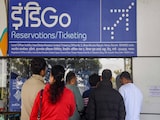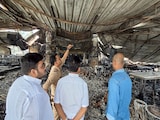- Three Air India pilots attempted to recreate scenarios leading to the AI-171 crash in Mumbai
- Investigators are examining the jet's black box data and fuel switch positions for insights
- AI-171 managed to gain altitude safely in various simulated scenarios with a single engine
A week after the crash of AI-171 on June 12, at least three Air India training pilots on the airline's Boeing 787 fleet attempted to recreate likely scenarios in Mumbai that resulted in the accident in which 260 people were killed.
The pilots attempted to simulate electrical failures that could cause a dual-engine flame-out, resulting in an inability of the aircraft to climb post takeoff.
They were unsuccessful.
Accident investigators, who have already downloaded data from the jetliner's black boxes (flight data recorders and cockpit voice recorders), will also examine the position of the fuel switches on the 787 and corroborate this data with any wreckage of the fuel switches that may have been found. This would be crucial in ascertaining whether any of the engines were accidentally switched off by the pilots during a critical phase of the flight - the takeoff run or shortly after the aircraft lifted off from Ahmedabad.
To ensure they were accurate in their simulation scenarios, the pilots replicated the precise trim sheet data of AI-171. A trim sheet is a document used in aviation to calculate and record an aircraft's weight and balance, ensuring the center of gravity is within safe limits for takeoff, flight, and landing.
The trainer-pilots also simulated the failure of a single engine, left the undercarriage of the aircraft down, and retracted the flaps of the 787 completely.
This configuration, considered unsafe and improper for normal takeoffs, was meant to simulate an underpowered jetliner taking off with its bulky undercarriage deployed (down). The undercarriage of an aircraft is normally stowed in its fuselage shortly after takeoff to ensure the jetliner is aerodynamic and can climb out efficiently.
What's more, an improper take-off flap configuration was also selected. This would make it even more challenging for the 787 to climb away on a single engine. Takeoff flaps are adjustable surfaces on an aircraft's wings that are extended during takeoff to increase lift, or the ability of an aircraft to climb.
In all of the scenarios described here, AI-171, with a single operational engine, was able to gain altitude safely. Air India's Boeing 787-8's General Electric GEnx-1B67-K turbo-fans have been uprated to produce a significant 70,000 pounds of thrust each. These are among the most powerful engines developed for civilian aircraft in the class of Boeing 787.
A dual-engine failure, as widely speculated, would, however, be catastrophic.
Pilots on Air India's Boeing 787 fleet are not trained to deal with a dual-engine failure at an altitude of less than 400 feet, as in the case of AI-171. This would be considered 'negative training', in other words, training for scenarios where the chances of successful recovery are technically not possible.
Put simply, a dual-engine failure at the altitude AI-171 was flying in, would have likely resulted in a crash.
Several pilots NDTV has spoken to are looking closely at the outcome of the Aircraft Accident Investigation Bureau's (AAIB) preliminary report, expected next week, which they hope will point to reasons that resulted in a dual-engine failure. Such a failure was believed to be only a statistical possibility, hardly realistic in the case of a major airline operating under ICAO (International Civil Aviation Organisation) protocols for maintenance, pilot training, and overall safety.
The outcome of the investigations will be critical for Air India, which operates 33 Boeing 787 Dreamliners, consisting of 26 Boeing 787-8s and 7 Boeing 787-9s. The airline operates more Dreamliners than any other twin-aisle jet in its fleet. A systemic failure on the Dreamliner, which extends beyond Air India, could have an impact on Boeing and dozens of airlines around the world that operate the jetliner, a mainstay in international civil aviation. Significantly, General Electric, a leader in the commercial jet engine market, would be waiting for the outcome of the report.
AI-171 was the first crash of a Boeing 787 Dreamliner since the aircraft entered service in October 2011.















